Missile defense of Japan
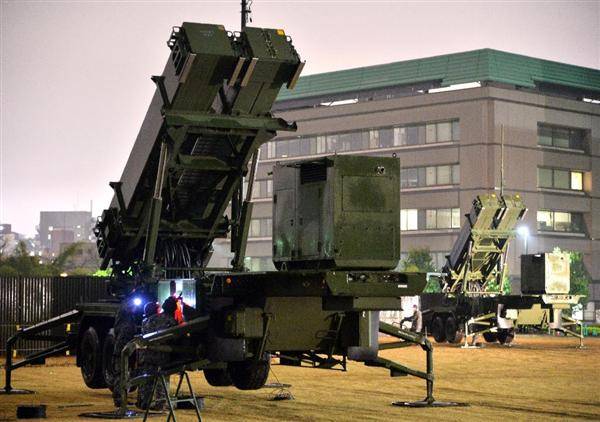
The formal reason for the creation and improvement of the Japanese missile defense system is the North Korean nuclear missile program. Foreign experts believe that as of 2020, the DPRK had more than 30 nuclear warheads. Pyongyang has several hundred operational-tactical missiles at its disposal. Also in North Korea, MRBMs, SLBMs and ICBMs have been created and successfully tested. These missiles, in addition to high-explosive fragmentation warheads, can be equipped with cluster, chemical and nuclear warheads.
However, it should be understood that the DPRK's capabilities in delivering ballistic missile strikes against Japan cannot be compared with the potential of Russia and China. The massive launch of North Korean missiles at targets in other states and the use of a few nuclear warheads are only possible in the event of an aggravation of the situation in the region, when the North Korean leadership considers that an attack on their country is inevitable. In a different situation, the unprovoked use of a nuclear missile weapons will lead to a coordinated attack on Pyongyang by the Republic of Korea, the United States and Japan. It is clear that in such a situation, the DPRK has no chance of victory, and this will lead to the physical destruction of the top North Korean military-political leadership.
When Chinese and Russian ballistic missiles are used against Japan (which is theoretically possible in the event of an unconditional victory of the Air and Naval Self-Defense Forces in the battle at sea and in the seizure of disputed territories), despite the fact that the United States is likely to get involved in the conflict, the consequences for Japan will be disastrous.
Thus, Japan's missile defense, on the one hand, is designed to protect against North Korean missiles with low accuracy, and on the other, together with the American "nuclear umbrella" should drastically reduce the possible damage in the event of a limited-scale missile strike by the PRC and Russia.
Already, the Japanese missile defense system is capable of repelling a missile attack from the DPRK with a high degree of probability. At the same time, intercepting 100 percent of Chinese and Russian ballistic missiles is an impossible task. I must say that in a hypothetical confrontation with Japan, the Chinese capabilities are now much higher than the Russian ones. The PLA has approximately 100 DF-21 and DF-26 MRBMs. There are no missiles of this class in our armed forces yet.
American military experts in 2017, based on publicly available data on US bases in Japan and published provisions of the Chinese defense doctrine, identified the priority 100 targets that could be targeted by a missile strike: airfields, ports, command posts, communications centers, troop deployments, weapons depots , material and technical property and fuels and lubricants. In the arsenal of the PLA, there are enough ballistic and cruise missiles to destroy all intended targets.
Ground-based anti-missile systems deployed in Japan
The first Japanese anti-aircraft missile system with anti-missile capabilities was the American-made Patriot air defense system.
From 1990 to 1996, Japan purchased 20 Patriot PAC-2 batteries. This modification was mainly sharpened to combat aerodynamic targets, and during the hostilities in the Middle East, it demonstrated not very high effectiveness against Iraqi operational-tactical ballistic missiles.
In connection with the North Korean missile threat, starting in 2007, the Air Self-Defense Forces received an additional six batteries of the Patriot PAC-3 air defense system. In 2010, a program of overhaul and modernization of out-of-date Patriot PAC-2 air defense systems was launched. At the same time, some of the existing complexes were brought to the level of PAC-3. In total, 3 complexes of the previous modification are planned to be converted into PAC-16.
Since 2015, the Patriot PAC-3 air defense system has been gradually modernized into the PAC-3 MSE. The maximum range of interception of ballistic targets for this modification is 24 km. Height reach - 20 km. The maximum flight speed of the SAM is 1480 m / s. The probability of destruction of the OTR warhead is 0,6–0,8.
A batch of 32 MIM-104F (MSE) missiles was purchased for the upgraded Patriot complexes in the United States. But basically, the Patriot PAC-3 MSE air defense systems that are in service with the Air Self-Defense Forces of Japan should be equipped with Japanese-made anti-aircraft missiles.
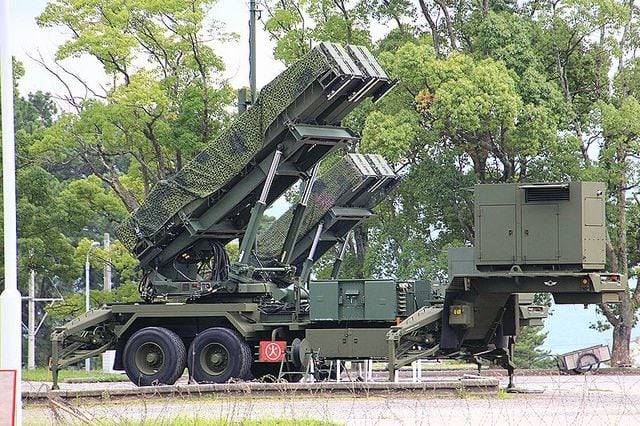
However, the command of the Japan Self-Defense Forces is aware that even the upgraded Patriot is not an effective anti-missile system, but only slightly increases the ability to intercept ballistic targets in the near zone when used in conjunction with more advanced and long-range missile defense systems.
In the period from 2009 to 2018, six anti-aircraft groups of the Japanese Air Self-Defense Forces were in firing positions in different parts of the country, armed with 24 PAC-2 and PAC-3 batteries. In 2006, the US Army deployed four Patriot PAC-3 air defense systems in the vicinity of the Kadena airbase on the island of Okinawa. During the period of greatest combat readiness, 120 Japanese launchers (480 ready-to-use missiles) and 20 American launchers (100 ready-to-use missiles) were deployed at the positions.
After tensions subsided, the number of Japanese Patriot batteries on alert dropped to twenty. At the same time, most of the complexes of the Air Self-Defense Forces are on duty with a truncated composition, and instead of 5 launchers, there are 3-4 launchers at the position.
Also, some recent photographs of Japanese anti-aircraft missile systems show that instead of four missiles, there are two missiles on the launchers. Okinawa now has two full complement American anti-aircraft batteries.
Currently, 16 Type 03 medium-range air defense systems are operating in the air defense units of the Ground Self-Defense Forces. It is expected that these complexes will be brought to the level of Type 03 Kai. The upgraded Type 03 Kai anti-missile complex was tested in 2015 at the American White Sands test site.
According to information published in Japanese sources, the range of destruction of ballistic missiles reaches 16 km. Ceiling - 12 km. The main purpose of the Type 03 Kai air defense system is to protect important defense facilities and troop concentrations from air attack weapons and ballistic operational-tactical missiles. If necessary, Type 03 Kai can be used as part of a national missile defense system.
Anti-aircraft missile systems "Patriot" and Type 03 Kai are capable of intercepting ballistic missiles only on the descending atmospheric branch of the trajectory, and in fact they are the last line of anti-missile defense. To reliably defeat a ballistic target, it must be fired upon by 2-3 anti-aircraft missiles.
The proprietary radar detection systems attached to the Patriot and Type 03 Kai air defense systems are capable of detecting a ballistic missile attack at short range, which results in an acute shortage of decision-making time. The J / FPS-3, J / FPS-5 and AN / TPY-2 radar stations are currently used for timely warning and target designation to existing ground-based missile defense systems. In the future, they will be supplemented with new J / FPS-7 and AN / SPY-7 (V) radars.
Promising ground-based anti-missile systems, the deployment of which was planned in Japan
At the end of 2012, the North Korean launch vehicle Eunha-3 was tested, after which the Japanese leadership decided to deploy long-range anti-missile systems. The American mobile anti-missile system THAAD (Terminal High Altitude Area Defense - a complex for high-altitude transatmospheric interception) was considered as the most quickly implemented option.
The AN / TPY-2 radar, which is part of the THAAD anti-missile system, is capable of detecting a ballistic missile warhead at a range of 1000 km. The THAAD anti-missile system is equipped with an uncooled IR seeker and an inertial radio command control system. To destroy a target in a direct collision, the kinetic energy of an all-metal warhead is used. The THAAD anti-missile missile with a length of 6,17 meters has a launch weight of 900 kg.
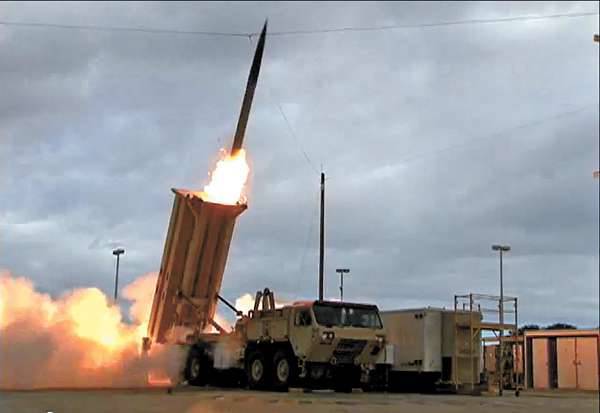
Launching an anti-missile THAAD
The launch is carried out by a detachable launch accelerator. The single-stage engine accelerates the anti-missile to a speed of 2,8 km / s. The firing range is up to 200 km. The THAAD missile battery has six launchers with 24 anti-missiles.
In the event of a THAAD miss, the Patriot air defense missile system takes over. According to the calculations of American specialists, the probability of a ballistic missile being hit by a two-echelon missile defense system, consisting of THAAD and Patriot PAC-3, should be at least 0,95.
The deployment of THAAD in Japan was facilitated by the fact that AN / TPY-2006 radar stations began operating in Aomori and Kyoto prefectures in 2014 and 2, served by personnel from the 10th and 14th anti-missile batteries of the US Army.
In September 2017, a THAAD missile defense battery was deployed in the Republic of Korea, 300 kilometers southeast of Seoul, to protect against North Korean missiles. Initially, on the territory of the Japanese islands, the deployment of two mobile American anti-missile systems was envisaged. All in all, to ensure combat stability and the necessary probability and protection of all facilities in Japan, six such batteries are required. According to preliminary calculations, the total cost of such a missile defense element will be $ 6,5 billion. The main advantage of the THAAD system is the ability to quickly change firing positions based on the developed Japanese road network.
But due to the fact that THAAD is a near-line missile defense system, mainly designed to protect against attacks by ballistic missiles with a launch range of up to 1000 km, the Japanese leadership considered it unsuitable for use as the basis for building a national missile defense system. The fact that the THAAD complexes were to remain under the jurisdiction of the American military, and the Japanese wanted to be independent in deciding on the use of anti-missile weapons, could play a role.
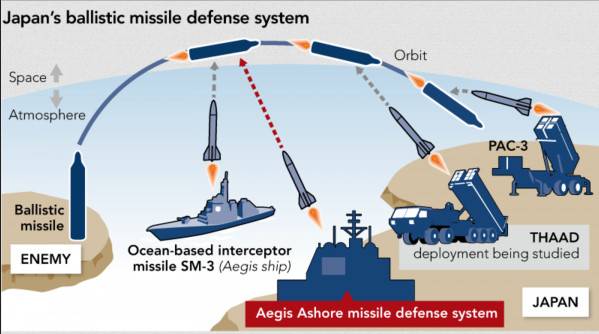
So, according to American experts, the Japanese missile defense system should have worked.
The stationary missile defense system AAMDS (Aegis Ashore Missile Defense System - AAMDS) was considered as a more effective alternative to the THAAD mobile complex. In 2017, at the height of the Korean crisis, the Japanese government opted for two US AAMDS ground systems, each costing about $ 890 million. The total cost of deployment, taking into account personnel training and the supply of anti-aircraft missiles, was supposed to be $ 2,15 billion.
It was assumed that the AAMDS would become an "umbrella" capable of reliably ensuring the country's security in the future. Missile defense systems were supposed to enter service by 2023. They were planned to be deployed on opposite ends of the island of Honshu: in Akita prefecture in the north and in Yamaguchi prefecture in southwestern Japan.
AAMDS is the land-based version of the Aegis maritime system. The first ground-based complex with 24 SM-3 Block IB interceptors was deployed in southern Romania in 2016.
The key components of the existing Aegis missile defense system are the SM-3 interceptor missiles of the Standard family and the AN / SPY-1 radar station. As part of the Japanese Aegis Ashore, the much more advanced AN / SPY-7 (V) radar was to be used. The maximum range of the SM-3 Block IB is 700 km, the speed is 3 km / s. The new SM-3 Block IIА anti-missile missile has much more impressive characteristics. The firing range of the SM-3 Block IIА is 2000 km, the maximum defeat height is 1000 km. The mass of the kinetic interceptor is 23 kg, the speed is 4,5 km / s.
It was assumed that in the future, to reduce the cost of operating missile defense systems in the production of SM-3 Block IIА anti-missiles, Japanese companies would take part. Back in 2006, an anti-missile missile was tested, equipped with experimental elements of Japanese design, providing increased acceleration characteristics.
In addition to these missiles, the SM-6 long-range missiles were to be included in the ammunition of the Japanese anti-missile systems. This missile is glider-unified with the early SM-2ER Block IV missile. Instead of a semi-active radar seeker, an active radar seeker from the air-to-air missile launcher AIM-120C AMRAAM is used in the final guidance segment. The SM-6 missile has a maximum flight speed of 1,2 km / s and can intercept long-range cruise missiles and ballistic missiles at the end of the trajectory.
On June 15, 2020, Japanese Defense Minister Taro Kono announced that work on the deployment of the AAMDS system was stopped, as additional costs would be required in excess of the approved budget. In addition, when launching interceptor missiles, there is a high probability that residential buildings will be hit by detachable rocket boosters, which excludes firing practice.
In the same month, Japan's National Security Council confirmed the cancellation of a plan to deploy a ground-based missile defense system. Instead, it was decided to develop a national naval missile defense component.
Japan's naval missile defense component
It is no secret that at the moment Japan has a very powerful military fleet, many times superior in size and combat power to the Pacific Fleet of the Russian Navy.
In 1993, the Maritime Self-Defense Forces received the destroyer URO "Congo", which is an analogue of the American destroyer URO of the "Arleigh Burke" type. In 1998, the Maritime Self-Defense Forces already had four such destroyers. They are equipped with American BIUS Aegis with AN / SPY-1D multifunctional radar.
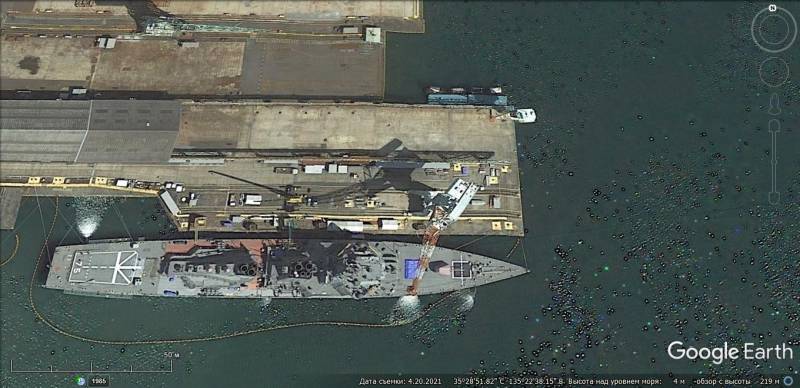
Satellite image of Google Earth: the destroyer URO "Congo" at the parking lot of the Maizuru naval base
The Atago-class destroyers (2 units), which entered service in 2007 and 2008, are a further development of the Congo-class destroyers and are equipped with the updated Aegis CIUS (AWS Baseline 7).
On June 23, 2006, the Japanese destroyer Kirishima took part in tests of the American SM-3 Block IA anti-missile missile, carrying out escort and simulating targeting. In March 2007, the Congo destroyer was redesigned to launch the SM-3 Block IA interceptor missiles. In October of the same year, he was near Hawaii in order to test the missile defense system. On November 6 and 15, he managed to track two real targets during the test of interceptor missiles from an American ship.
In December 2007, the SM-3 Block IA anti-missile missile was launched from the Congo destroyer, successfully destroying the training target. This was the first time an interceptor missile was launched from a Japanese ship during the testing of the Aegis missile defense system. To launch anti-missiles, the vertical launch system (VLS) Mk. 41.

Launch of the SM-3 Block IA anti-missile from a Japanese destroyer
In September 2018, as part of a test over the Pacific Ocean, a ballistic missile launched from a test site on the island of Kauai in Hawaii was intercepted. The SM-3 Block IB anti-missile missile was launched from the Japanese destroyer Atago.
On March 19, 2020, at the Japan Marine United shipyard in Yokohama, the ceremony of introducing into the Japanese Navy the destroyer URO "Maya" (pr. 27DDG) - the first Japanese ship armed with SM-3 Block IIA anti-missile missiles, with an improved Aegis system (AWS Baseline 9C) and radar AN / SPY-7. The cost of designing and building the missile destroyer Maya was $ 1,6 billion.
The ships of the project 27DDG became the development of the Atago-class destroyers. The May building has become 5 meters longer and reaches 170 meters. The displacement increased from 7750 to 8200 tons.
On March 19, 2021, the second Maya-class destroyer Haguro entered service. It is reported that this warship is equipped with two vertical launch units Mk.41 (64 cells in the bow, 32 cells in the aft), designed for anti-aircraft missiles SM-2MR Block IIIB, anti-missile SM-3 Block IIA and SM-6, and also Type 07 anti-submarine missiles. In addition, the destroyer's arsenal includes a 127-mm gun mount, two 20-mm self-defense anti-aircraft artillery systems, Type 17 anti-ship missiles and two 324-mm torpedo tubes. The destroyer is equipped with a new data exchange system. It allows information from guidance radars from one destroyer equipped with Aegis to be used to intercept missiles by another ship of a similar class.
In December 2020, the Japanese government approved a plan to strengthen the missile defense, providing for the construction of two more destroyers equipped with Aegis BIUS, AN / SPY-7 radar, SM-3 Block IIA and SM-6 anti-missiles. The Japanese media say that the deployed sea-based missile defense system should become an effective tool against both ballistic and cruise and hypersonic missiles. According to preliminary estimates, the construction of two new ships will require the allocation of $ 4,8-5 billion.
As already mentioned in the article American air defense forces, aviation reconnaissance and control systems deployed in Japan Naval Base Yokosuka is the home base for the forward-based nuclear-powered aircraft carrier Ronald Reagan, part of the 5th Aircraft Carrier Strike Group of the US 7th Fleet. This group also includes six Arleigh Burke-class destroyers and three Ticonderoga-class cruisers. There is reason to believe that some of these American destroyers and cruisers are also equipped with anti-missiles and, in the event of a ballistic missile attack, they will be used to protect American military bases located on the Japanese islands.
Advantages and disadvantages of Japan's missile defense system
Currently, Japan has built a two-tier missile defense system.
Destroyers with the Aegis system are armed with interceptor missiles, which must shoot down a ballistic missile in the middle of its trajectory. If this fails, the second level of missile defense will be activated: using the Patriot PAC-3 mobile complexes, capable of intercepting a missile at the final stage of the flight.
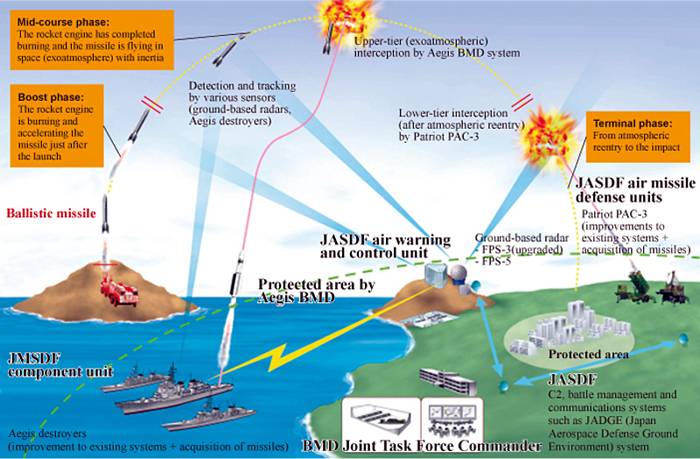
Japan's missile defense system is mainly designed to protect against MRBMs, such as the Chinese DF-21 and DF-26, as well as the North Korean "Musudan". The destroyers, armed with anti-missile missiles, are based in the Sasebo and Maizuru naval bases in the southern and central parts of the country. That, taking into account the firing range of the SM-3 Block IIA, is enough to cover the entire territory of Japan with two missile defense ships.
Information about how many Japanese destroyers have been converted to use the SM-3 Block IA and SM-3 Block IB interceptors is contradictory. Judging by publications in foreign media, there are at least four such ships. With two Maya-class destroyers recently commissioned and armed with SM-3 Block IIA and SM-6 interceptors, the Japan Maritime Self-Defense Forces could have six missile defense ships. Japanese sources say that onboard missile defense ships, in addition to other weapons, it is envisaged to have 10-12 interceptor missiles capable of fighting ballistic missiles.
According to expert estimates, Japan's ground and naval missile defense components should ensure the simultaneous interception of 20-30 warheads (a limited-scale strike).
In the event of a global nuclear missile apocalypse, Japanese missile defense will not matter.
Compared to the land-based stationary missile defense system AAMDS, destroyers equipped with anti-missile missiles, due to their mobility, are less vulnerable to a disarming strike by ballistic and cruise missiles. However, the cost of building and operating such ships is much higher. In addition, they can be destroyed at sea by anti-ship missiles and torpedoes.
Experts note that the noise immunity of radars combined with the Aegis BIUS, in the conditions of the enemy's use of false targets and generators of active jamming, may turn out to be insufficient.
In addition, in the event of a massive strike, the Aegis system is likely to be oversaturated with numerous simultaneously attacking warheads, and there may not be enough interceptor missiles on board destroyers. All tests of American interceptor missiles were carried out in "greenhouse" conditions, and it is unclear how the missile defense system will behave in a real combat situation.
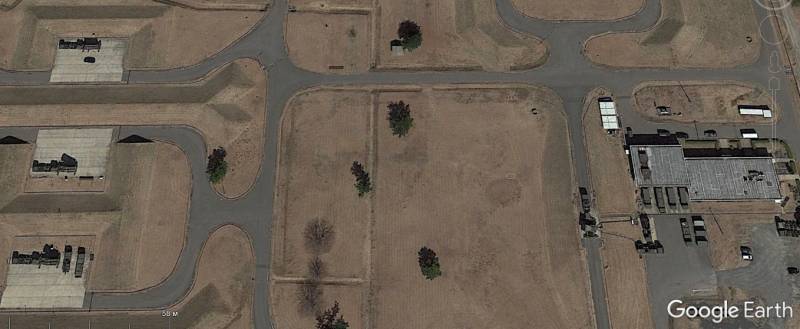
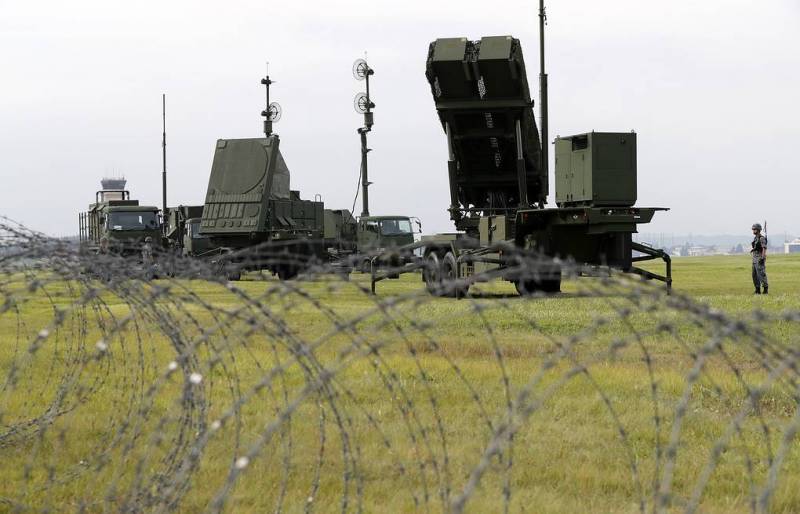
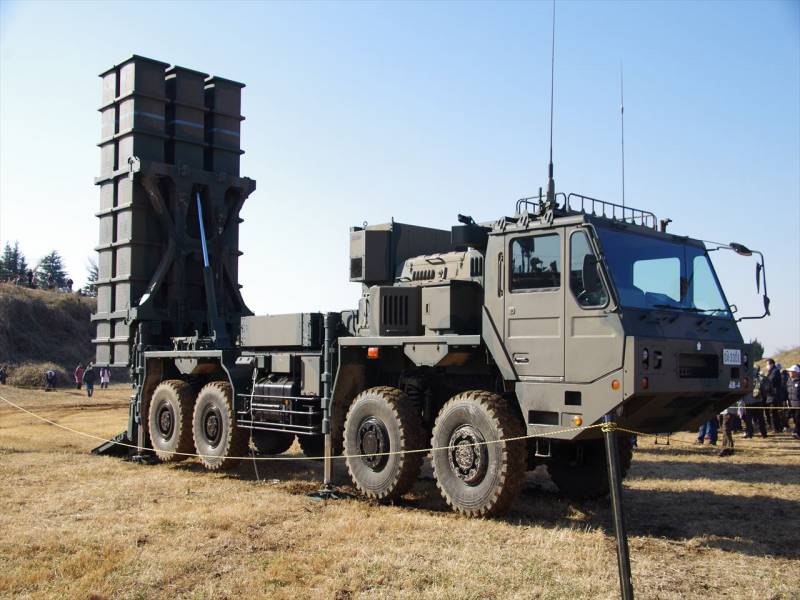
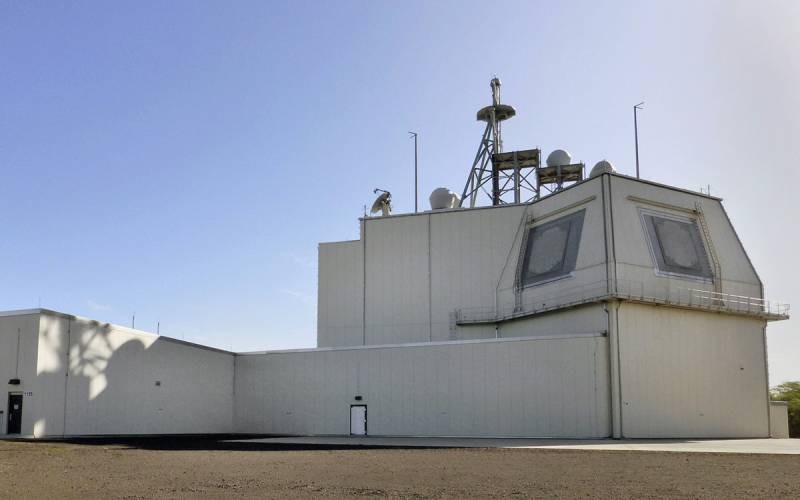
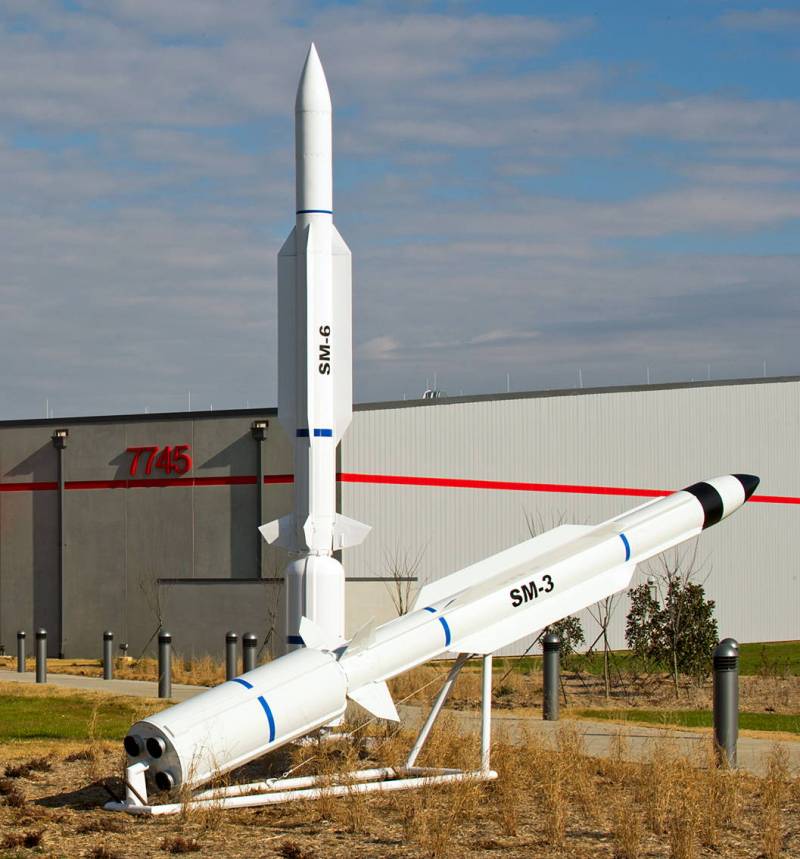
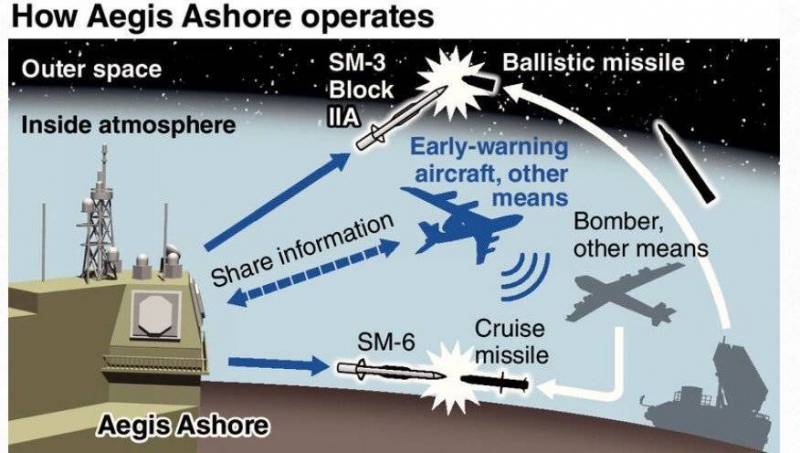
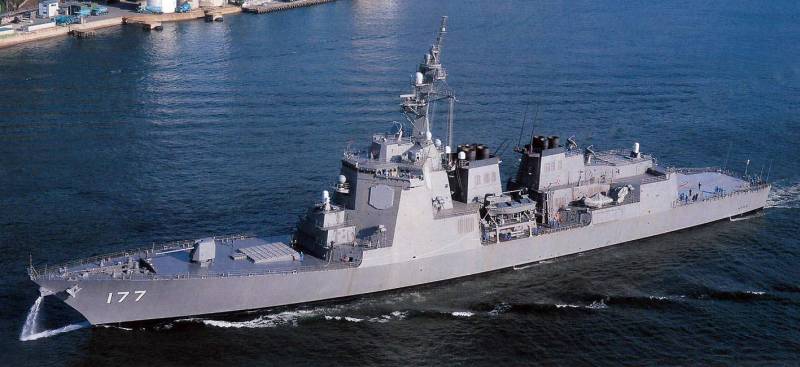
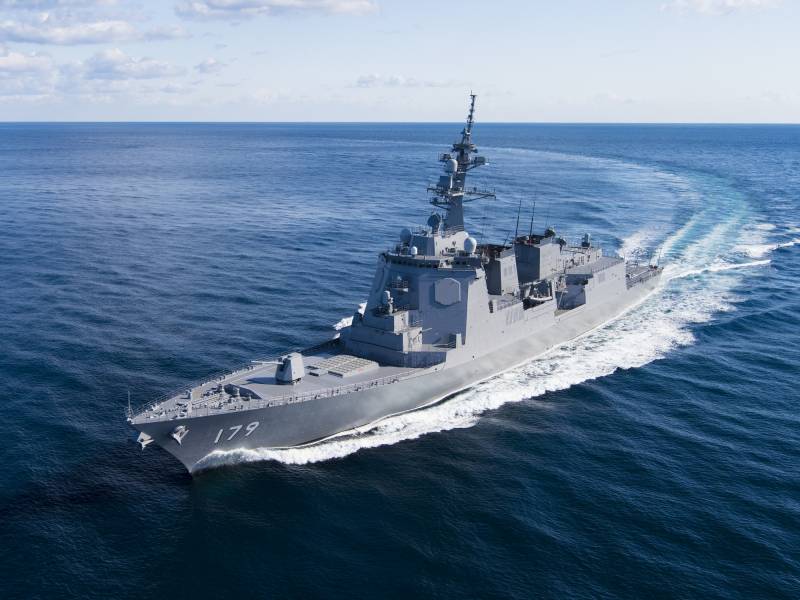
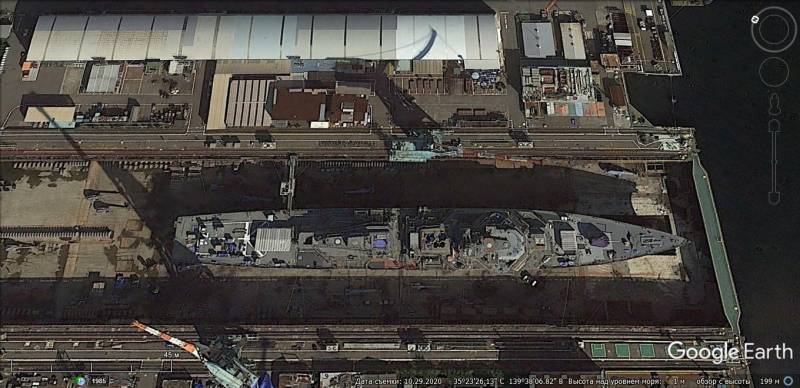
Information